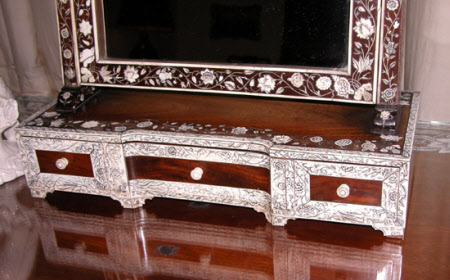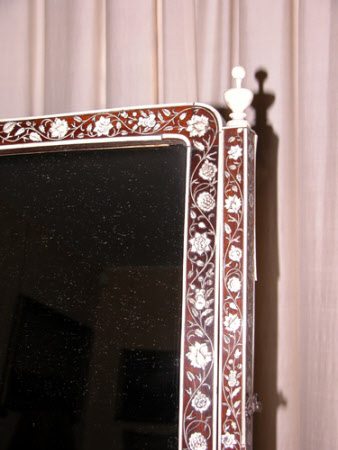Dressing mirror
Category
Furniture
Date
circa 1770
Materials
Padouk and ivory
Measurements
69.6 x 48.3 x 20.8 cm
Place of origin
Vizagapatam
Order this imageCollection
Anglesey Abbey, Cambridgeshire
NT 514494
Summary
An ivory inlaid and engraved ivory cross banded padouk dressing table mirror or toilet mirror, Indian, Vizagapatam, circa 1770 The rectangular mirrored plate within a frame inlaid with trailing flowers and held by square section supports surmounted by turned ivory urn finials. The base with an inverted breakfront with three drawers, inlaid with further trailing floral decoration and engraved cross banded ivory borders, raised on bracket feet.
Full description
This dressing table mirror is inspired by English models produced circa 1725-1750. It was made at Vizagapatam, a port on the east coast of India famous for its fine cabinet work. The maker has decorated the face of the dressing table with a combination of ivory inlay and ivory veneer in a style of the 1750s. 1760 to 1780 was a period of transition between the two techniques practiced by Vizagapatam workshops. The use of ivory veneer gave makers a greater degree of flexibility. They could decorate more freely and easily by engraving on ivory than by inlaying ivory into a wooden ground, both techniques are present here. A similar example is in the Clive Collection, Powis Castle, Wales - National Trust collection NT 1180669 which was acquired by Robert Clive (d.1774). Clive served a number of terms in India, first travelling to Madras in 1744 as a writer or clerk in the East India Company though distinguishing himself in military actions, and then serving in Bombay (1755-60) and Bengal (1765-67).The dressing mirror, together with a similar dressing table, must have been acquired in his first or second term of service since it is recorded that the feet were replaced by the London cabinet-maker George Bradshaw in 1761. See: Jaffer, Amin 'Furniture from British India and Ceylon' V&A publications 2001 James Weedon (October 2017)
Provenance
Bequeathed to the National Trust by Huttleston Rogers Broughton, 1st Lord Fairhaven (1896-1966) with the house and the rest of the contents.
References
Jaffer 2001 : Amin Jaffer, Furniture from British India and Ceylon, a catalogue of the collection in the Victoria and Albert Museum and the Peabody Essex Museum, London, V&A publications, 2001. Jaffer 2002 : "Luxury goods from India, the art of the Indian cabinet maker", London, V&A publications, 2002.


